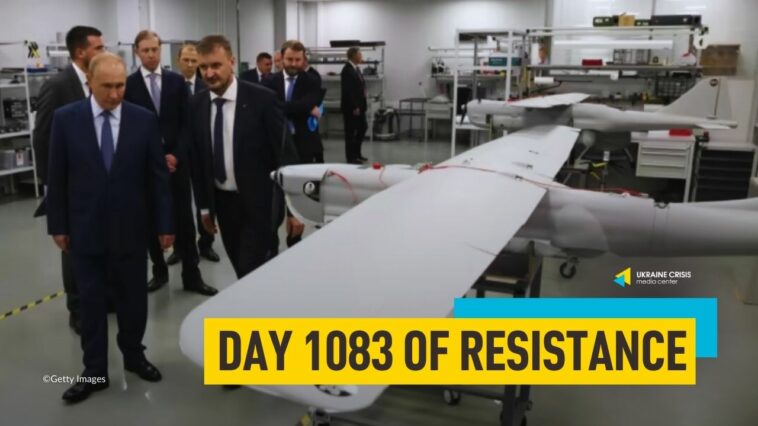Russia leverages technological innovations developed in Ukraine war directly against NATO, ISW says. None of 83 Russian drones launched at Ukraine overnight hit target. Europe holds talks on large-scale seizures of Russia’s oil-exporting tankers in the Baltic Sea, according to Politico.
Russia leverages technological innovations developed in Ukraine war directly against NATO, ISW says
Russia appears to be leveraging the technological innovations it is developing in its war in Ukraine directly against NATO states, the Institute for the Study of War (ISW) said in a report on Sunday. The paragraphs below are quoted from the report.
Russia has been developing and improving its drone capabilities, including drone resistance to electronic warfare (EW) and Russia’s own EW capabilities, in its ongoing war against Ukraine.
NATO and its member states have increasingly warned of Russian sabotage and hybrid operations against NATO members throughout 2024.
Reports that a NATO member state is struggling to combat likely Russian reconnaissance drones demonstrate the need for NATO states to further develop their defensive capabilities as Russia continues to use its experience on the battlefield in Ukraine to innovate new technologies.
Here are the key takeaways that ISW offered in its report.
Russia continues to leverage its partnerships with US adversaries, including North Korea, to offset the resource shortages constraining Russia’s economy and war effort.
The arrival of North Korean workers to Russia demonstrates how Russia, a permanent member of the United Nations Security Council (UNSC), is violating UNSC Resolution 2397.
North Korean dictator Kim Jong Un continues to reiterate his support for Russia and its war effort in Ukraine.
German authorities reportedly failed to down suspected Russian reconnaissance drones flying near a German military facility in January 2025 where Ukrainian forces have undergone training.
Ukrainian forces recently advanced in Kursk Oblast and near Vovchansk (in Kharkiv region).
Russian forces recently advanced near Toretsk, Pokrovsk, and Velyka Novosilka (in Donetsk region).
Russia continues efforts to recruit Russians and citizens of other Commonwealth of Independent State (CIS) countries to sign military service contracts with the Russian Ministry of Defense (MoD).
Ukraine destroys all 83 drones, decoys launched by Russia overnight
The Ukrainian Air Force said on Monday that it shot down 61 out of 83 drones launched by Russia overnight. Twenty-two decoy drones disappeared off radar after likely being disabled by electronic warfare systems.
The intercepts took place over the regions of Chernihiv, Dnipro, Kharkiv, Kherson, Khmelnytskyi, Kropyvnytskyi, Kyiv, Mykolaiv, Poltava, Sumy, and Zaporizhzhia, Ukraine’s Air Force said.
The attack caused damaged in the regions of Kharkiv, Kropyvnytskyi, Poltava, and Sumy, it added.
The drones were launched from the area of Russia’s Kursk, Oryol, Millerovo, Shatalovo, Bryansk, and Primorsko-Akhtarsk. The Air Force and other branches of the Ukrainian military deployed aircraft, surface-to-air missile troops, electronic warfare units and mobile groups to repel the attack.
Europe holds talks on large-scale seizures of Russia’s oil-exporting tankers in Baltic Sea, according to Politico
European countries are pushing for new powers to squeeze Moscow’s shadow fleet after a spate of incidents in the Baltic Sea, Politico said Monday. The paragraphs below are quoted from the article.
Finnish authorities seized the Eagle S ship in December in an all-guns-blazing operation, suspecting it had sabotaged a subsea power link connecting Estonia to Finland. The detention of the ship — which was carrying 100,000 barrels of oil from St. Petersburg — was a galvanizing moment, and appeared to be a new front in a clandestine war between Russia and the West.
Now, European countries are holding behind-the-scenes talks on large-scale seizures of Moscow’s oil-exporting tankers in the Baltic Sea, according to two European Union diplomats and two government officials. They are also currently drafting new legislation to add legal heft to those efforts.
The proposals being considered include using international law to grab vessels on environmental or piracy grounds, said the officials, who were granted anonymity to discuss the private talks. Failing that, the countries could go it on their own, jointly imposing fresh national laws to seize more ships further out at sea.
“Close to 50 percent of sanctioned trade [in Russian seaborne oil] is going through the Gulf of Finland,” said Estonia’s Foreign Minister Margus Tsahkna. “There are the environmental threats, there are the attacks we’ve had against our undersea infrastructure.”
The talks illustrate Europe’s growing frustration that Russia continues to transport its oil and dodge Western sanctions by relying on an ever-growing “shadow fleet” — aging vessels with obscure ownership and unknown insurance. By doing so, Moscow has been able to preserve a key lifeline for its war effort in Ukraine, given that oil and gas generate around half of the Kremlin’s revenues.
And it’s all happening right under Europe’s nose, in its own waterways.
As a result, “the shadow fleet is now transporting over 80 percent of all Russian crude oil,” said Isaac Levi, the Russia-Europe lead at the Centre for Research on Energy and Clean Air think tank.
The Baltic Sea is the critical artery for that illegal trade, he argued.
Last year, 348 shadow fleet vessels making up 40 percent of Russia’s total oil sales departed from Baltic ports, Levi said — a figure equivalent to a third of Moscow’s annual defense budget.
Still, the new plans won’t easily be translated into action. According to experts and maritime lawyers, difficulties include legal retaliation from Russia, steep financial costs and onerous logistics.

